Business Law Report: English Legal System, Employment and ADR Analysis
VerifiedAdded on 2020/07/22
|14
|4092
|27
Report
AI Summary
This business law report provides a comprehensive overview of the English legal system, exploring its structure and sources of law. It details the role of the government in law-making, differentiating between statutory and common law. The report then delves into employer's legal obligations, covering occupational health and safety, worker's compensation, harassment policies, and equal opportunities, alongside the impact of relevant employment and contract law. It analyzes a case study involving a food outlet, highlighting legal violations and their consequences. Furthermore, the report examines legal solutions for business problems, specifically focusing on a case study involving disclosure of confidential information and breaches of contract. Finally, it discusses the importance of Alternative Dispute Resolution (ADR) processes and provides recommendations for a specific case involving Antwon and Tyrell, concluding with a summary of key findings and recommendations.
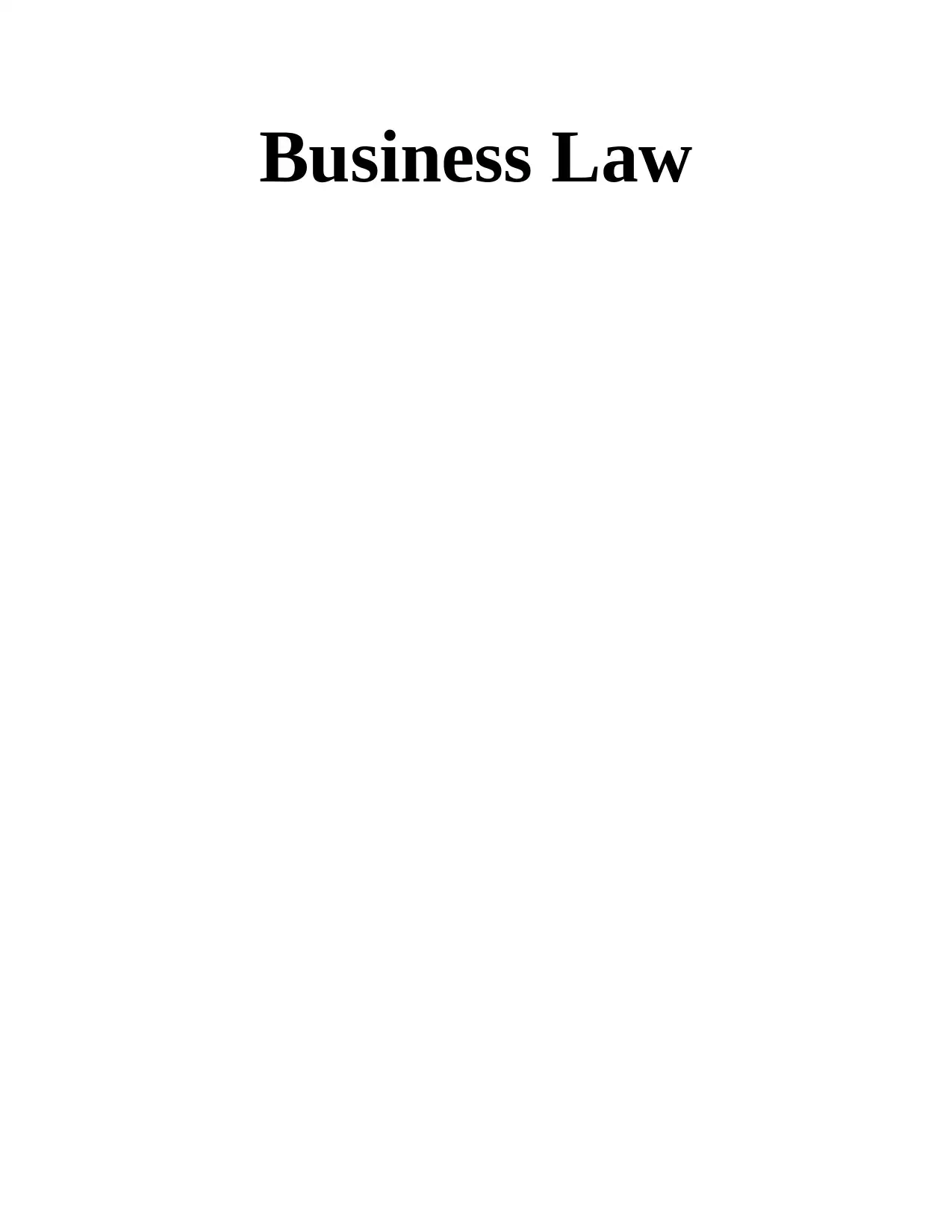
Business Law
Paraphrase This Document
Need a fresh take? Get an instant paraphrase of this document with our AI Paraphraser
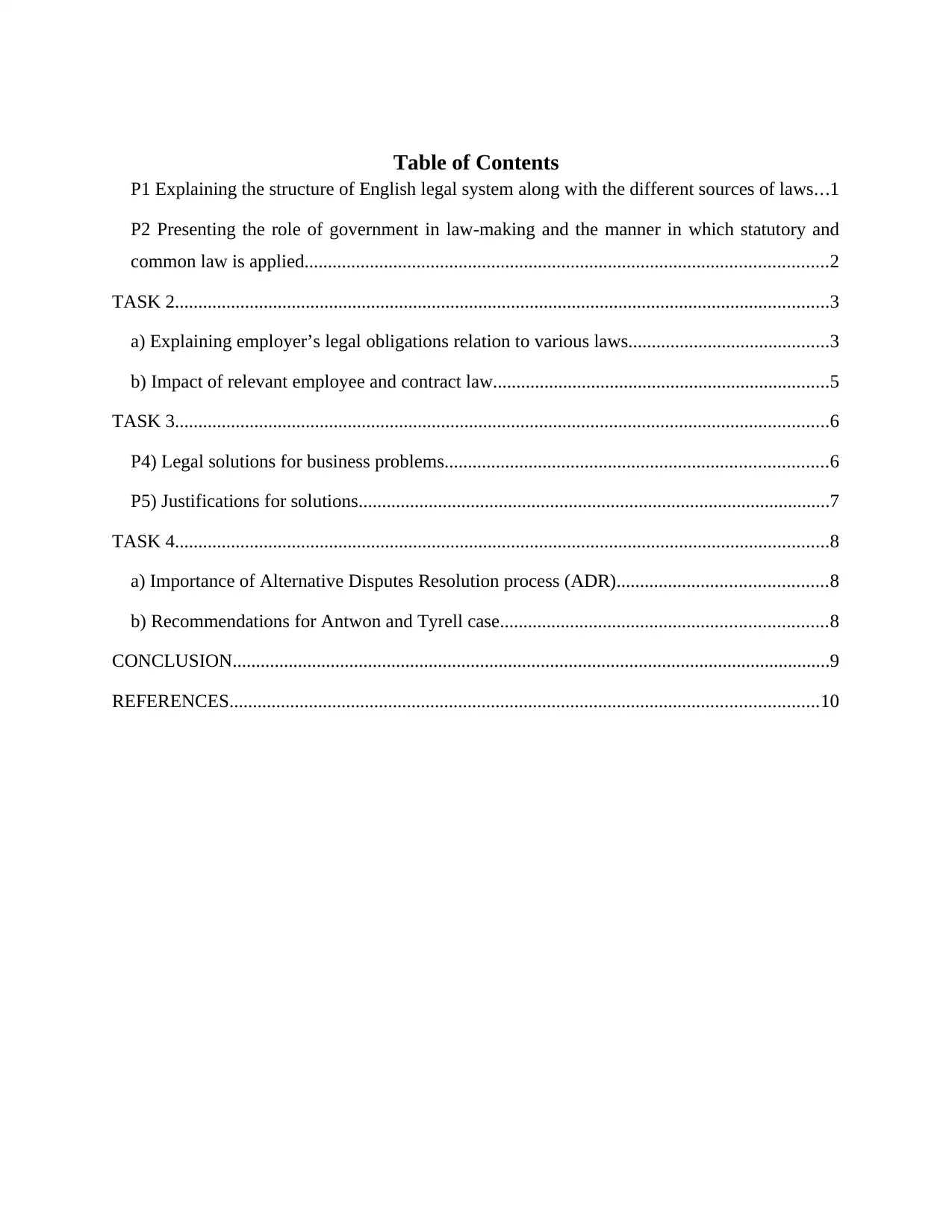
Table of Contents
P1 Explaining the structure of English legal system along with the different sources of laws...1
P2 Presenting the role of government in law-making and the manner in which statutory and
common law is applied................................................................................................................2
TASK 2............................................................................................................................................3
a) Explaining employer’s legal obligations relation to various laws...........................................3
b) Impact of relevant employee and contract law........................................................................5
TASK 3............................................................................................................................................6
P4) Legal solutions for business problems..................................................................................6
P5) Justifications for solutions.....................................................................................................7
TASK 4............................................................................................................................................8
a) Importance of Alternative Disputes Resolution process (ADR).............................................8
b) Recommendations for Antwon and Tyrell case......................................................................8
CONCLUSION................................................................................................................................9
REFERENCES..............................................................................................................................10
P1 Explaining the structure of English legal system along with the different sources of laws...1
P2 Presenting the role of government in law-making and the manner in which statutory and
common law is applied................................................................................................................2
TASK 2............................................................................................................................................3
a) Explaining employer’s legal obligations relation to various laws...........................................3
b) Impact of relevant employee and contract law........................................................................5
TASK 3............................................................................................................................................6
P4) Legal solutions for business problems..................................................................................6
P5) Justifications for solutions.....................................................................................................7
TASK 4............................................................................................................................................8
a) Importance of Alternative Disputes Resolution process (ADR).............................................8
b) Recommendations for Antwon and Tyrell case......................................................................8
CONCLUSION................................................................................................................................9
REFERENCES..............................................................................................................................10
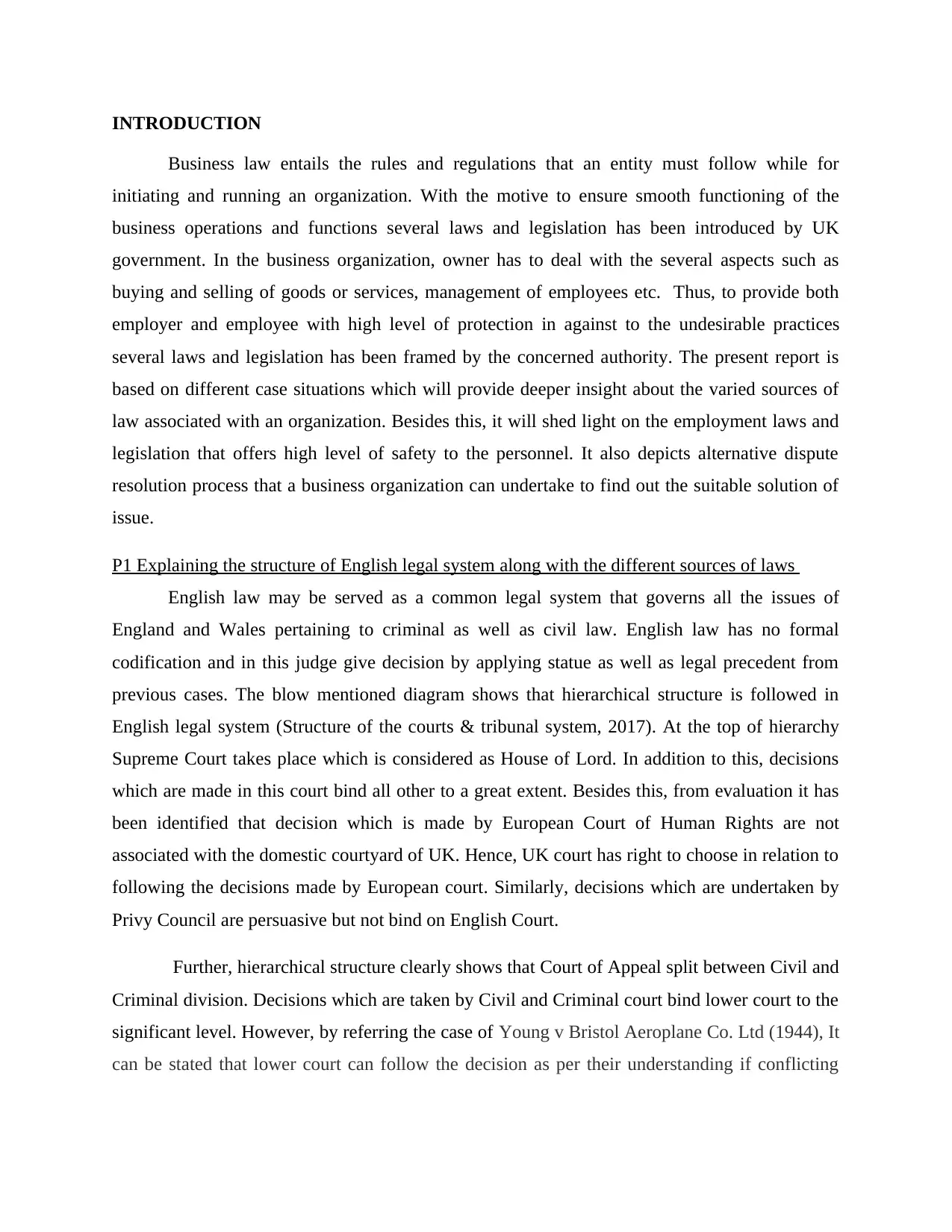
INTRODUCTION
Business law entails the rules and regulations that an entity must follow while for
initiating and running an organization. With the motive to ensure smooth functioning of the
business operations and functions several laws and legislation has been introduced by UK
government. In the business organization, owner has to deal with the several aspects such as
buying and selling of goods or services, management of employees etc. Thus, to provide both
employer and employee with high level of protection in against to the undesirable practices
several laws and legislation has been framed by the concerned authority. The present report is
based on different case situations which will provide deeper insight about the varied sources of
law associated with an organization. Besides this, it will shed light on the employment laws and
legislation that offers high level of safety to the personnel. It also depicts alternative dispute
resolution process that a business organization can undertake to find out the suitable solution of
issue.
P1 Explaining the structure of English legal system along with the different sources of laws
English law may be served as a common legal system that governs all the issues of
England and Wales pertaining to criminal as well as civil law. English law has no formal
codification and in this judge give decision by applying statue as well as legal precedent from
previous cases. The blow mentioned diagram shows that hierarchical structure is followed in
English legal system (Structure of the courts & tribunal system, 2017). At the top of hierarchy
Supreme Court takes place which is considered as House of Lord. In addition to this, decisions
which are made in this court bind all other to a great extent. Besides this, from evaluation it has
been identified that decision which is made by European Court of Human Rights are not
associated with the domestic courtyard of UK. Hence, UK court has right to choose in relation to
following the decisions made by European court. Similarly, decisions which are undertaken by
Privy Council are persuasive but not bind on English Court.
Further, hierarchical structure clearly shows that Court of Appeal split between Civil and
Criminal division. Decisions which are taken by Civil and Criminal court bind lower court to the
significant level. However, by referring the case of Young v Bristol Aeroplane Co. Ltd (1944), It
can be stated that lower court can follow the decision as per their understanding if conflicting
Business law entails the rules and regulations that an entity must follow while for
initiating and running an organization. With the motive to ensure smooth functioning of the
business operations and functions several laws and legislation has been introduced by UK
government. In the business organization, owner has to deal with the several aspects such as
buying and selling of goods or services, management of employees etc. Thus, to provide both
employer and employee with high level of protection in against to the undesirable practices
several laws and legislation has been framed by the concerned authority. The present report is
based on different case situations which will provide deeper insight about the varied sources of
law associated with an organization. Besides this, it will shed light on the employment laws and
legislation that offers high level of safety to the personnel. It also depicts alternative dispute
resolution process that a business organization can undertake to find out the suitable solution of
issue.
P1 Explaining the structure of English legal system along with the different sources of laws
English law may be served as a common legal system that governs all the issues of
England and Wales pertaining to criminal as well as civil law. English law has no formal
codification and in this judge give decision by applying statue as well as legal precedent from
previous cases. The blow mentioned diagram shows that hierarchical structure is followed in
English legal system (Structure of the courts & tribunal system, 2017). At the top of hierarchy
Supreme Court takes place which is considered as House of Lord. In addition to this, decisions
which are made in this court bind all other to a great extent. Besides this, from evaluation it has
been identified that decision which is made by European Court of Human Rights are not
associated with the domestic courtyard of UK. Hence, UK court has right to choose in relation to
following the decisions made by European court. Similarly, decisions which are undertaken by
Privy Council are persuasive but not bind on English Court.
Further, hierarchical structure clearly shows that Court of Appeal split between Civil and
Criminal division. Decisions which are taken by Civil and Criminal court bind lower court to the
significant level. However, by referring the case of Young v Bristol Aeroplane Co. Ltd (1944), It
can be stated that lower court can follow the decision as per their understanding if conflicting
⊘ This is a preview!⊘
Do you want full access?
Subscribe today to unlock all pages.

Trusted by 1+ million students worldwide
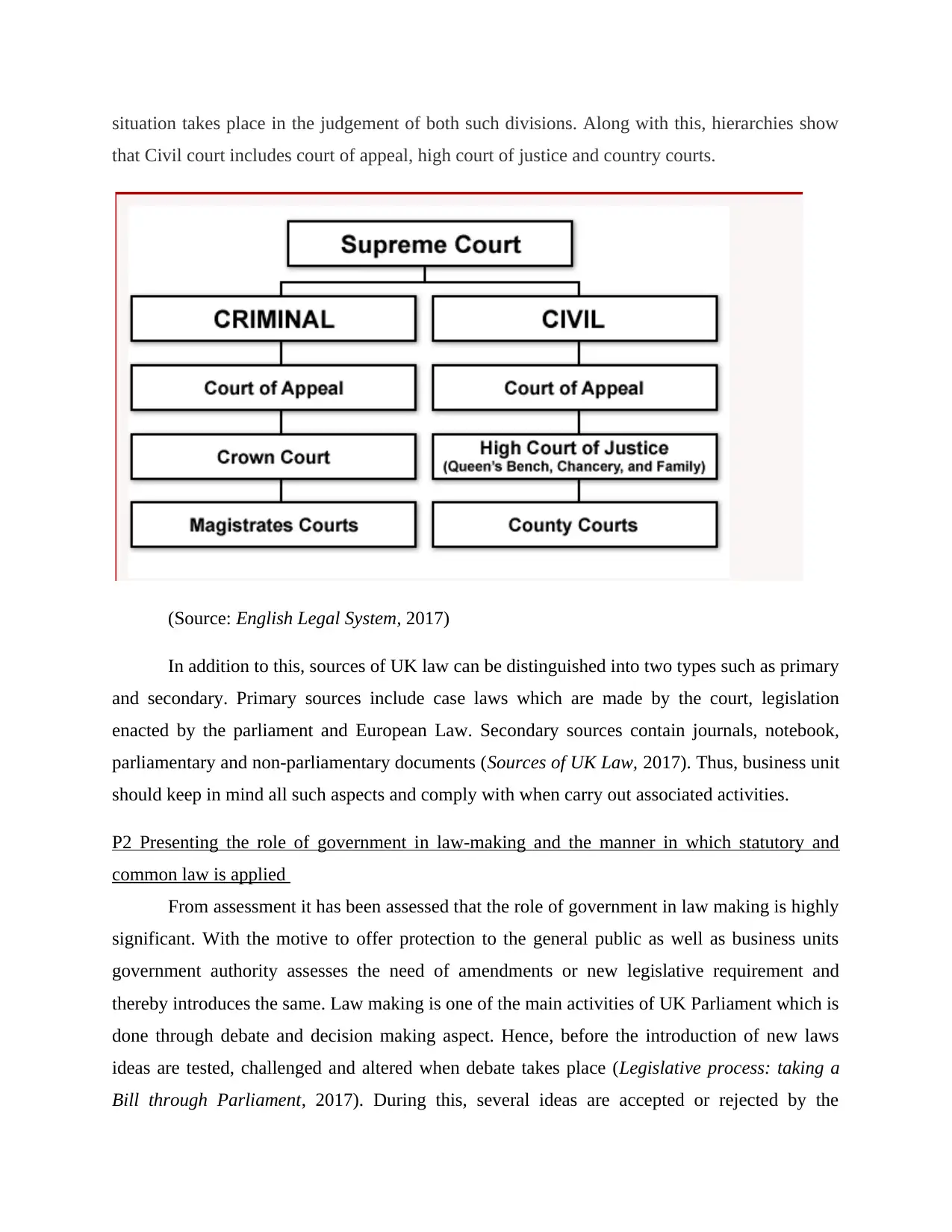
situation takes place in the judgement of both such divisions. Along with this, hierarchies show
that Civil court includes court of appeal, high court of justice and country courts.
(Source: English Legal System, 2017)
In addition to this, sources of UK law can be distinguished into two types such as primary
and secondary. Primary sources include case laws which are made by the court, legislation
enacted by the parliament and European Law. Secondary sources contain journals, notebook,
parliamentary and non-parliamentary documents (Sources of UK Law, 2017). Thus, business unit
should keep in mind all such aspects and comply with when carry out associated activities.
P2 Presenting the role of government in law-making and the manner in which statutory and
common law is applied
From assessment it has been assessed that the role of government in law making is highly
significant. With the motive to offer protection to the general public as well as business units
government authority assesses the need of amendments or new legislative requirement and
thereby introduces the same. Law making is one of the main activities of UK Parliament which is
done through debate and decision making aspect. Hence, before the introduction of new laws
ideas are tested, challenged and altered when debate takes place (Legislative process: taking a
Bill through Parliament, 2017). During this, several ideas are accepted or rejected by the
that Civil court includes court of appeal, high court of justice and country courts.
(Source: English Legal System, 2017)
In addition to this, sources of UK law can be distinguished into two types such as primary
and secondary. Primary sources include case laws which are made by the court, legislation
enacted by the parliament and European Law. Secondary sources contain journals, notebook,
parliamentary and non-parliamentary documents (Sources of UK Law, 2017). Thus, business unit
should keep in mind all such aspects and comply with when carry out associated activities.
P2 Presenting the role of government in law-making and the manner in which statutory and
common law is applied
From assessment it has been assessed that the role of government in law making is highly
significant. With the motive to offer protection to the general public as well as business units
government authority assesses the need of amendments or new legislative requirement and
thereby introduces the same. Law making is one of the main activities of UK Parliament which is
done through debate and decision making aspect. Hence, before the introduction of new laws
ideas are tested, challenged and altered when debate takes place (Legislative process: taking a
Bill through Parliament, 2017). During this, several ideas are accepted or rejected by the
Paraphrase This Document
Need a fresh take? Get an instant paraphrase of this document with our AI Paraphraser
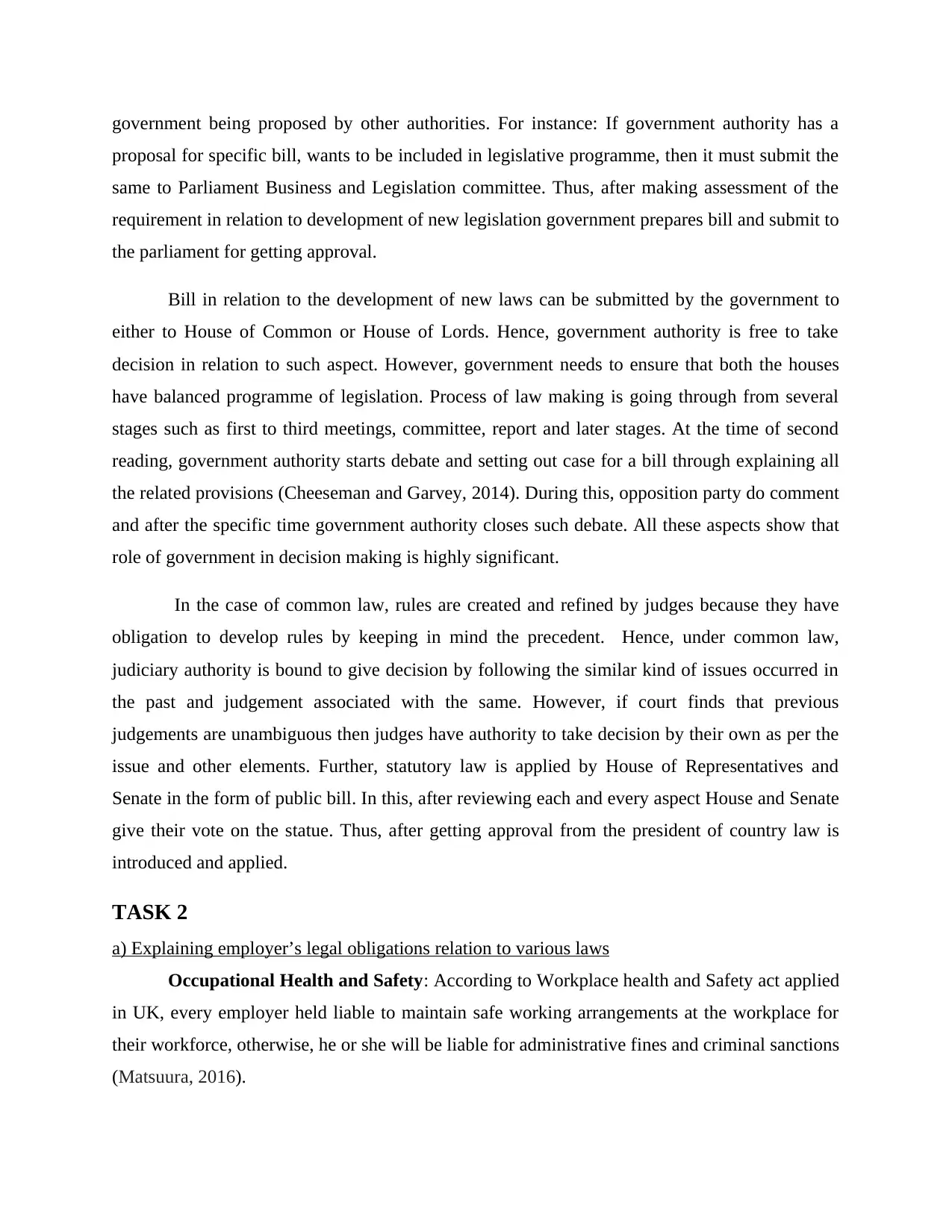
government being proposed by other authorities. For instance: If government authority has a
proposal for specific bill, wants to be included in legislative programme, then it must submit the
same to Parliament Business and Legislation committee. Thus, after making assessment of the
requirement in relation to development of new legislation government prepares bill and submit to
the parliament for getting approval.
Bill in relation to the development of new laws can be submitted by the government to
either to House of Common or House of Lords. Hence, government authority is free to take
decision in relation to such aspect. However, government needs to ensure that both the houses
have balanced programme of legislation. Process of law making is going through from several
stages such as first to third meetings, committee, report and later stages. At the time of second
reading, government authority starts debate and setting out case for a bill through explaining all
the related provisions (Cheeseman and Garvey, 2014). During this, opposition party do comment
and after the specific time government authority closes such debate. All these aspects show that
role of government in decision making is highly significant.
In the case of common law, rules are created and refined by judges because they have
obligation to develop rules by keeping in mind the precedent. Hence, under common law,
judiciary authority is bound to give decision by following the similar kind of issues occurred in
the past and judgement associated with the same. However, if court finds that previous
judgements are unambiguous then judges have authority to take decision by their own as per the
issue and other elements. Further, statutory law is applied by House of Representatives and
Senate in the form of public bill. In this, after reviewing each and every aspect House and Senate
give their vote on the statue. Thus, after getting approval from the president of country law is
introduced and applied.
TASK 2
a) Explaining employer’s legal obligations relation to various laws
Occupational Health and Safety: According to Workplace health and Safety act applied
in UK, every employer held liable to maintain safe working arrangements at the workplace for
their workforce, otherwise, he or she will be liable for administrative fines and criminal sanctions
(Matsuura, 2016).
proposal for specific bill, wants to be included in legislative programme, then it must submit the
same to Parliament Business and Legislation committee. Thus, after making assessment of the
requirement in relation to development of new legislation government prepares bill and submit to
the parliament for getting approval.
Bill in relation to the development of new laws can be submitted by the government to
either to House of Common or House of Lords. Hence, government authority is free to take
decision in relation to such aspect. However, government needs to ensure that both the houses
have balanced programme of legislation. Process of law making is going through from several
stages such as first to third meetings, committee, report and later stages. At the time of second
reading, government authority starts debate and setting out case for a bill through explaining all
the related provisions (Cheeseman and Garvey, 2014). During this, opposition party do comment
and after the specific time government authority closes such debate. All these aspects show that
role of government in decision making is highly significant.
In the case of common law, rules are created and refined by judges because they have
obligation to develop rules by keeping in mind the precedent. Hence, under common law,
judiciary authority is bound to give decision by following the similar kind of issues occurred in
the past and judgement associated with the same. However, if court finds that previous
judgements are unambiguous then judges have authority to take decision by their own as per the
issue and other elements. Further, statutory law is applied by House of Representatives and
Senate in the form of public bill. In this, after reviewing each and every aspect House and Senate
give their vote on the statue. Thus, after getting approval from the president of country law is
introduced and applied.
TASK 2
a) Explaining employer’s legal obligations relation to various laws
Occupational Health and Safety: According to Workplace health and Safety act applied
in UK, every employer held liable to maintain safe working arrangements at the workplace for
their workforce, otherwise, he or she will be liable for administrative fines and criminal sanctions
(Matsuura, 2016).
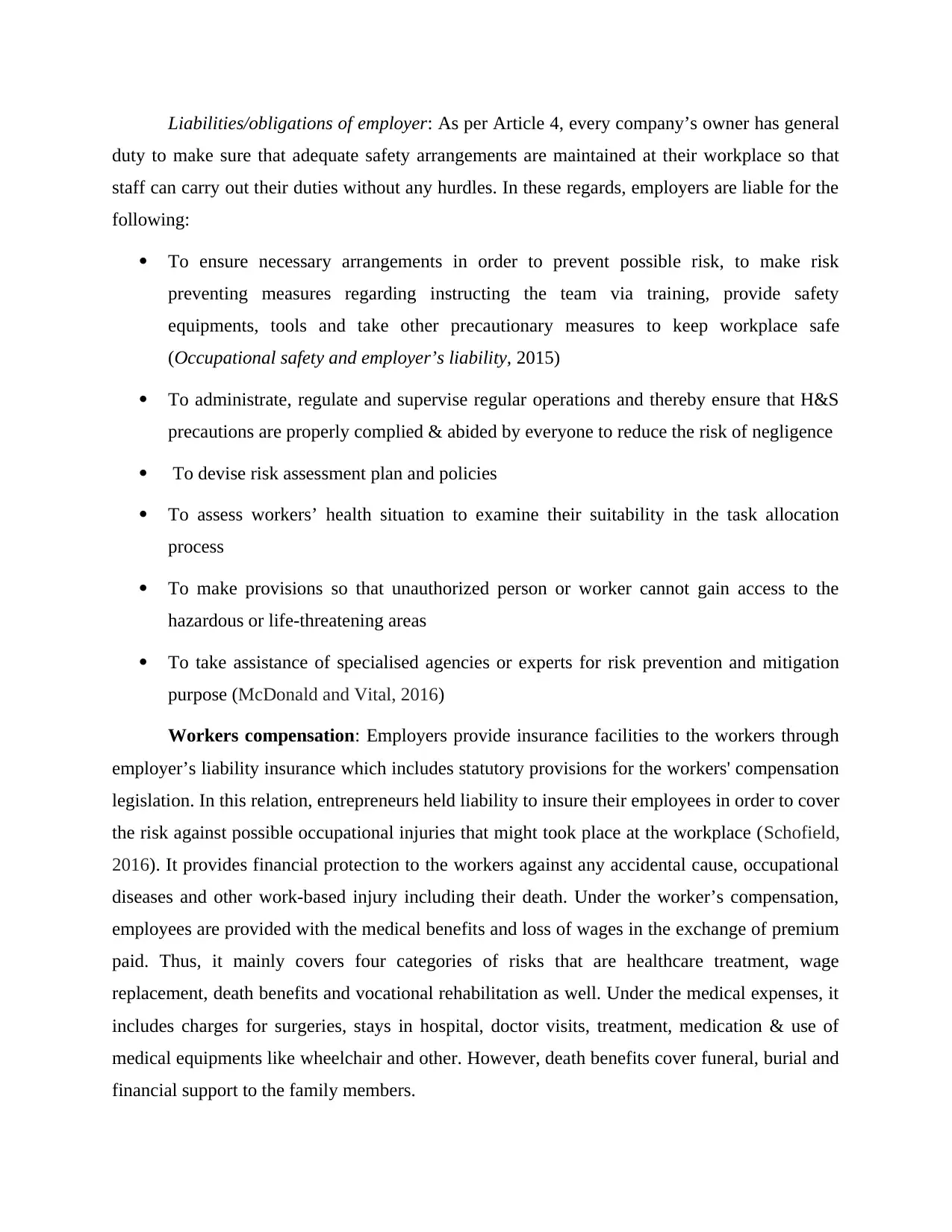
Liabilities/obligations of employer: As per Article 4, every company’s owner has general
duty to make sure that adequate safety arrangements are maintained at their workplace so that
staff can carry out their duties without any hurdles. In these regards, employers are liable for the
following:
To ensure necessary arrangements in order to prevent possible risk, to make risk
preventing measures regarding instructing the team via training, provide safety
equipments, tools and take other precautionary measures to keep workplace safe
(Occupational safety and employer’s liability, 2015)
To administrate, regulate and supervise regular operations and thereby ensure that H&S
precautions are properly complied & abided by everyone to reduce the risk of negligence
To devise risk assessment plan and policies
To assess workers’ health situation to examine their suitability in the task allocation
process
To make provisions so that unauthorized person or worker cannot gain access to the
hazardous or life-threatening areas
To take assistance of specialised agencies or experts for risk prevention and mitigation
purpose (McDonald and Vital, 2016)
Workers compensation: Employers provide insurance facilities to the workers through
employer’s liability insurance which includes statutory provisions for the workers' compensation
legislation. In this relation, entrepreneurs held liability to insure their employees in order to cover
the risk against possible occupational injuries that might took place at the workplace (Schofield,
2016). It provides financial protection to the workers against any accidental cause, occupational
diseases and other work-based injury including their death. Under the worker’s compensation,
employees are provided with the medical benefits and loss of wages in the exchange of premium
paid. Thus, it mainly covers four categories of risks that are healthcare treatment, wage
replacement, death benefits and vocational rehabilitation as well. Under the medical expenses, it
includes charges for surgeries, stays in hospital, doctor visits, treatment, medication & use of
medical equipments like wheelchair and other. However, death benefits cover funeral, burial and
financial support to the family members.
duty to make sure that adequate safety arrangements are maintained at their workplace so that
staff can carry out their duties without any hurdles. In these regards, employers are liable for the
following:
To ensure necessary arrangements in order to prevent possible risk, to make risk
preventing measures regarding instructing the team via training, provide safety
equipments, tools and take other precautionary measures to keep workplace safe
(Occupational safety and employer’s liability, 2015)
To administrate, regulate and supervise regular operations and thereby ensure that H&S
precautions are properly complied & abided by everyone to reduce the risk of negligence
To devise risk assessment plan and policies
To assess workers’ health situation to examine their suitability in the task allocation
process
To make provisions so that unauthorized person or worker cannot gain access to the
hazardous or life-threatening areas
To take assistance of specialised agencies or experts for risk prevention and mitigation
purpose (McDonald and Vital, 2016)
Workers compensation: Employers provide insurance facilities to the workers through
employer’s liability insurance which includes statutory provisions for the workers' compensation
legislation. In this relation, entrepreneurs held liability to insure their employees in order to cover
the risk against possible occupational injuries that might took place at the workplace (Schofield,
2016). It provides financial protection to the workers against any accidental cause, occupational
diseases and other work-based injury including their death. Under the worker’s compensation,
employees are provided with the medical benefits and loss of wages in the exchange of premium
paid. Thus, it mainly covers four categories of risks that are healthcare treatment, wage
replacement, death benefits and vocational rehabilitation as well. Under the medical expenses, it
includes charges for surgeries, stays in hospital, doctor visits, treatment, medication & use of
medical equipments like wheelchair and other. However, death benefits cover funeral, burial and
financial support to the family members.
⊘ This is a preview!⊘
Do you want full access?
Subscribe today to unlock all pages.

Trusted by 1+ million students worldwide

Harassments: Under the Harassment Act, it is clearly stated that employer held
accountable for the harassment of any of the worker by another that took place at workplace. It
can bring serious criminal issues to the owner under the harassment law (Employer’s liabilities
for Harassment, 2012). Following are the statutory obligation of the employer in relation to
harassment policy, presented below:
To ensure full disclosure of harassment policy in the employee handbook, manuals,
necessary documents
To properly communicate the policy in the staff training & development program
To take reasonable actions, precautions and decisions to prevent the issue of harassment
To implement necessary measures at the workplace in order to respond such issues
To give compensation to the harassed colleague
Equal opportunities: According to the Equality Act 2010, it is the responsibility of
employer to ensure anti-discrimination practices so that none of the worker is being
discriminated or unfairly treated by another employee (Wadham, Robinson and Ruebain, 2010).
In this regards, employer owes following obligations:
To provide equal opportunities to the workforce in recruitment & selection, training &
development, promotion and other advanced opportunities without any discrimination
To maintain equality in payroll system through designing equal pay structure for the
employees with same qualification and experience
To take necessary actions against the person who is held liable for any discrimination &
unfavourable treatment with other (Act, 2010)
To make proper arrangements to provide the best accommodation to physically
challenged members
b) Impact of relevant employee and contract law
According to the employment law in UK, employer cannot recruit an individual below
the age of 18 years as they come in the minor category. Evidencing from the case, food outlet
had employed a 16 year old girl which is illegal act as per the employment provisions and owner
will be held liable for the same. Besides this, taking into account the occupational health and
accountable for the harassment of any of the worker by another that took place at workplace. It
can bring serious criminal issues to the owner under the harassment law (Employer’s liabilities
for Harassment, 2012). Following are the statutory obligation of the employer in relation to
harassment policy, presented below:
To ensure full disclosure of harassment policy in the employee handbook, manuals,
necessary documents
To properly communicate the policy in the staff training & development program
To take reasonable actions, precautions and decisions to prevent the issue of harassment
To implement necessary measures at the workplace in order to respond such issues
To give compensation to the harassed colleague
Equal opportunities: According to the Equality Act 2010, it is the responsibility of
employer to ensure anti-discrimination practices so that none of the worker is being
discriminated or unfairly treated by another employee (Wadham, Robinson and Ruebain, 2010).
In this regards, employer owes following obligations:
To provide equal opportunities to the workforce in recruitment & selection, training &
development, promotion and other advanced opportunities without any discrimination
To maintain equality in payroll system through designing equal pay structure for the
employees with same qualification and experience
To take necessary actions against the person who is held liable for any discrimination &
unfavourable treatment with other (Act, 2010)
To make proper arrangements to provide the best accommodation to physically
challenged members
b) Impact of relevant employee and contract law
According to the employment law in UK, employer cannot recruit an individual below
the age of 18 years as they come in the minor category. Evidencing from the case, food outlet
had employed a 16 year old girl which is illegal act as per the employment provisions and owner
will be held liable for the same. Besides this, taking into account the occupational health and
Paraphrase This Document
Need a fresh take? Get an instant paraphrase of this document with our AI Paraphraser
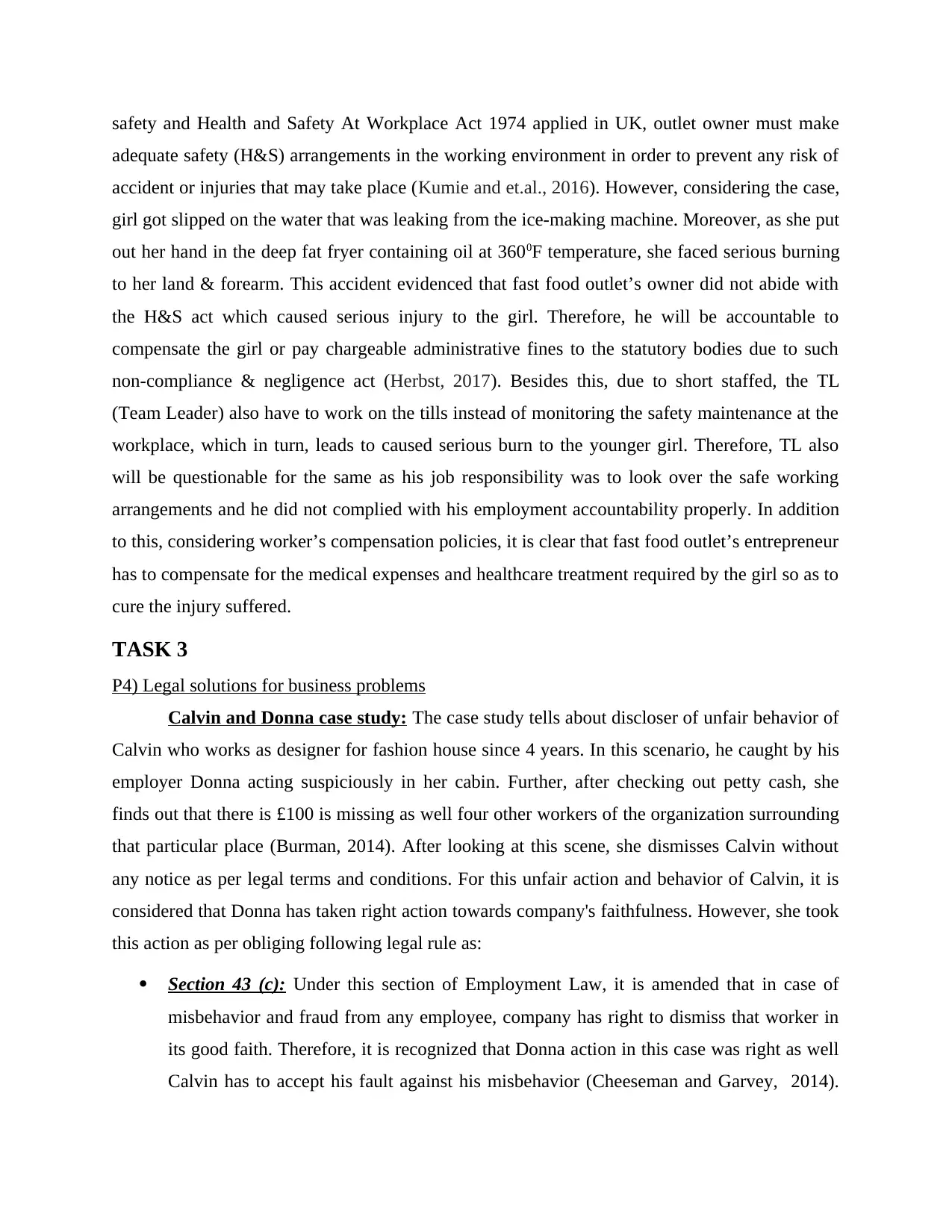
safety and Health and Safety At Workplace Act 1974 applied in UK, outlet owner must make
adequate safety (H&S) arrangements in the working environment in order to prevent any risk of
accident or injuries that may take place (Kumie and et.al., 2016). However, considering the case,
girl got slipped on the water that was leaking from the ice-making machine. Moreover, as she put
out her hand in the deep fat fryer containing oil at 3600F temperature, she faced serious burning
to her land & forearm. This accident evidenced that fast food outlet’s owner did not abide with
the H&S act which caused serious injury to the girl. Therefore, he will be accountable to
compensate the girl or pay chargeable administrative fines to the statutory bodies due to such
non-compliance & negligence act (Herbst, 2017). Besides this, due to short staffed, the TL
(Team Leader) also have to work on the tills instead of monitoring the safety maintenance at the
workplace, which in turn, leads to caused serious burn to the younger girl. Therefore, TL also
will be questionable for the same as his job responsibility was to look over the safe working
arrangements and he did not complied with his employment accountability properly. In addition
to this, considering worker’s compensation policies, it is clear that fast food outlet’s entrepreneur
has to compensate for the medical expenses and healthcare treatment required by the girl so as to
cure the injury suffered.
TASK 3
P4) Legal solutions for business problems
Calvin and Donna case study: The case study tells about discloser of unfair behavior of
Calvin who works as designer for fashion house since 4 years. In this scenario, he caught by his
employer Donna acting suspiciously in her cabin. Further, after checking out petty cash, she
finds out that there is £100 is missing as well four other workers of the organization surrounding
that particular place (Burman, 2014). After looking at this scene, she dismisses Calvin without
any notice as per legal terms and conditions. For this unfair action and behavior of Calvin, it is
considered that Donna has taken right action towards company's faithfulness. However, she took
this action as per obliging following legal rule as:
Section 43 (c): Under this section of Employment Law, it is amended that in case of
misbehavior and fraud from any employee, company has right to dismiss that worker in
its good faith. Therefore, it is recognized that Donna action in this case was right as well
Calvin has to accept his fault against his misbehavior (Cheeseman and Garvey, 2014).
adequate safety (H&S) arrangements in the working environment in order to prevent any risk of
accident or injuries that may take place (Kumie and et.al., 2016). However, considering the case,
girl got slipped on the water that was leaking from the ice-making machine. Moreover, as she put
out her hand in the deep fat fryer containing oil at 3600F temperature, she faced serious burning
to her land & forearm. This accident evidenced that fast food outlet’s owner did not abide with
the H&S act which caused serious injury to the girl. Therefore, he will be accountable to
compensate the girl or pay chargeable administrative fines to the statutory bodies due to such
non-compliance & negligence act (Herbst, 2017). Besides this, due to short staffed, the TL
(Team Leader) also have to work on the tills instead of monitoring the safety maintenance at the
workplace, which in turn, leads to caused serious burn to the younger girl. Therefore, TL also
will be questionable for the same as his job responsibility was to look over the safe working
arrangements and he did not complied with his employment accountability properly. In addition
to this, considering worker’s compensation policies, it is clear that fast food outlet’s entrepreneur
has to compensate for the medical expenses and healthcare treatment required by the girl so as to
cure the injury suffered.
TASK 3
P4) Legal solutions for business problems
Calvin and Donna case study: The case study tells about discloser of unfair behavior of
Calvin who works as designer for fashion house since 4 years. In this scenario, he caught by his
employer Donna acting suspiciously in her cabin. Further, after checking out petty cash, she
finds out that there is £100 is missing as well four other workers of the organization surrounding
that particular place (Burman, 2014). After looking at this scene, she dismisses Calvin without
any notice as per legal terms and conditions. For this unfair action and behavior of Calvin, it is
considered that Donna has taken right action towards company's faithfulness. However, she took
this action as per obliging following legal rule as:
Section 43 (c): Under this section of Employment Law, it is amended that in case of
misbehavior and fraud from any employee, company has right to dismiss that worker in
its good faith. Therefore, it is recognized that Donna action in this case was right as well
Calvin has to accept his fault against his misbehavior (Cheeseman and Garvey, 2014).
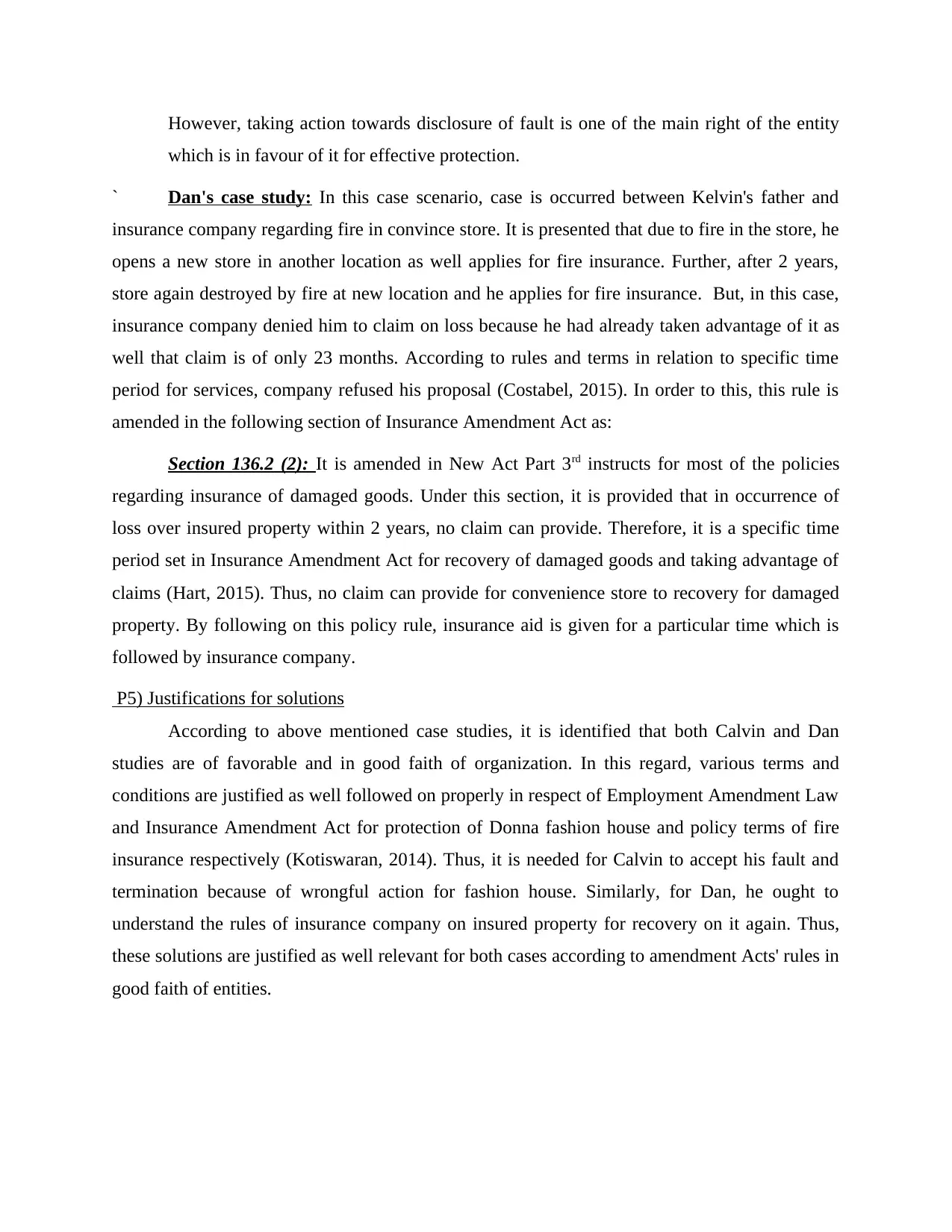
However, taking action towards disclosure of fault is one of the main right of the entity
which is in favour of it for effective protection.
` Dan's case study: In this case scenario, case is occurred between Kelvin's father and
insurance company regarding fire in convince store. It is presented that due to fire in the store, he
opens a new store in another location as well applies for fire insurance. Further, after 2 years,
store again destroyed by fire at new location and he applies for fire insurance. But, in this case,
insurance company denied him to claim on loss because he had already taken advantage of it as
well that claim is of only 23 months. According to rules and terms in relation to specific time
period for services, company refused his proposal (Costabel, 2015). In order to this, this rule is
amended in the following section of Insurance Amendment Act as:
Section 136.2 (2): It is amended in New Act Part 3rd instructs for most of the policies
regarding insurance of damaged goods. Under this section, it is provided that in occurrence of
loss over insured property within 2 years, no claim can provide. Therefore, it is a specific time
period set in Insurance Amendment Act for recovery of damaged goods and taking advantage of
claims (Hart, 2015). Thus, no claim can provide for convenience store to recovery for damaged
property. By following on this policy rule, insurance aid is given for a particular time which is
followed by insurance company.
P5) Justifications for solutions
According to above mentioned case studies, it is identified that both Calvin and Dan
studies are of favorable and in good faith of organization. In this regard, various terms and
conditions are justified as well followed on properly in respect of Employment Amendment Law
and Insurance Amendment Act for protection of Donna fashion house and policy terms of fire
insurance respectively (Kotiswaran, 2014). Thus, it is needed for Calvin to accept his fault and
termination because of wrongful action for fashion house. Similarly, for Dan, he ought to
understand the rules of insurance company on insured property for recovery on it again. Thus,
these solutions are justified as well relevant for both cases according to amendment Acts' rules in
good faith of entities.
which is in favour of it for effective protection.
` Dan's case study: In this case scenario, case is occurred between Kelvin's father and
insurance company regarding fire in convince store. It is presented that due to fire in the store, he
opens a new store in another location as well applies for fire insurance. Further, after 2 years,
store again destroyed by fire at new location and he applies for fire insurance. But, in this case,
insurance company denied him to claim on loss because he had already taken advantage of it as
well that claim is of only 23 months. According to rules and terms in relation to specific time
period for services, company refused his proposal (Costabel, 2015). In order to this, this rule is
amended in the following section of Insurance Amendment Act as:
Section 136.2 (2): It is amended in New Act Part 3rd instructs for most of the policies
regarding insurance of damaged goods. Under this section, it is provided that in occurrence of
loss over insured property within 2 years, no claim can provide. Therefore, it is a specific time
period set in Insurance Amendment Act for recovery of damaged goods and taking advantage of
claims (Hart, 2015). Thus, no claim can provide for convenience store to recovery for damaged
property. By following on this policy rule, insurance aid is given for a particular time which is
followed by insurance company.
P5) Justifications for solutions
According to above mentioned case studies, it is identified that both Calvin and Dan
studies are of favorable and in good faith of organization. In this regard, various terms and
conditions are justified as well followed on properly in respect of Employment Amendment Law
and Insurance Amendment Act for protection of Donna fashion house and policy terms of fire
insurance respectively (Kotiswaran, 2014). Thus, it is needed for Calvin to accept his fault and
termination because of wrongful action for fashion house. Similarly, for Dan, he ought to
understand the rules of insurance company on insured property for recovery on it again. Thus,
these solutions are justified as well relevant for both cases according to amendment Acts' rules in
good faith of entities.
⊘ This is a preview!⊘
Do you want full access?
Subscribe today to unlock all pages.

Trusted by 1+ million students worldwide
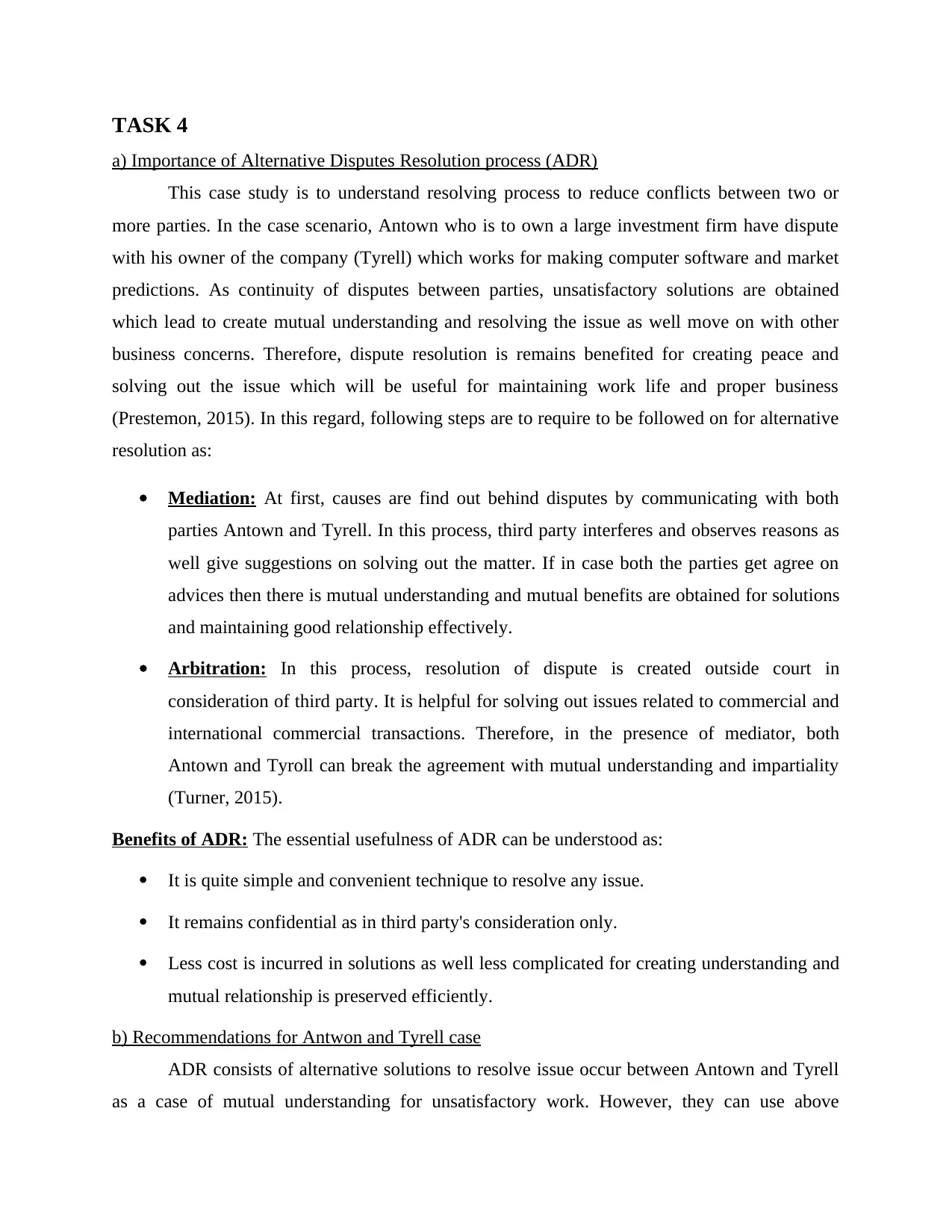
TASK 4
a) Importance of Alternative Disputes Resolution process (ADR)
This case study is to understand resolving process to reduce conflicts between two or
more parties. In the case scenario, Antown who is to own a large investment firm have dispute
with his owner of the company (Tyrell) which works for making computer software and market
predictions. As continuity of disputes between parties, unsatisfactory solutions are obtained
which lead to create mutual understanding and resolving the issue as well move on with other
business concerns. Therefore, dispute resolution is remains benefited for creating peace and
solving out the issue which will be useful for maintaining work life and proper business
(Prestemon, 2015). In this regard, following steps are to require to be followed on for alternative
resolution as:
Mediation: At first, causes are find out behind disputes by communicating with both
parties Antown and Tyrell. In this process, third party interferes and observes reasons as
well give suggestions on solving out the matter. If in case both the parties get agree on
advices then there is mutual understanding and mutual benefits are obtained for solutions
and maintaining good relationship effectively.
Arbitration: In this process, resolution of dispute is created outside court in
consideration of third party. It is helpful for solving out issues related to commercial and
international commercial transactions. Therefore, in the presence of mediator, both
Antown and Tyroll can break the agreement with mutual understanding and impartiality
(Turner, 2015).
Benefits of ADR: The essential usefulness of ADR can be understood as:
It is quite simple and convenient technique to resolve any issue.
It remains confidential as in third party's consideration only.
Less cost is incurred in solutions as well less complicated for creating understanding and
mutual relationship is preserved efficiently.
b) Recommendations for Antwon and Tyrell case
ADR consists of alternative solutions to resolve issue occur between Antown and Tyrell
as a case of mutual understanding for unsatisfactory work. However, they can use above
a) Importance of Alternative Disputes Resolution process (ADR)
This case study is to understand resolving process to reduce conflicts between two or
more parties. In the case scenario, Antown who is to own a large investment firm have dispute
with his owner of the company (Tyrell) which works for making computer software and market
predictions. As continuity of disputes between parties, unsatisfactory solutions are obtained
which lead to create mutual understanding and resolving the issue as well move on with other
business concerns. Therefore, dispute resolution is remains benefited for creating peace and
solving out the issue which will be useful for maintaining work life and proper business
(Prestemon, 2015). In this regard, following steps are to require to be followed on for alternative
resolution as:
Mediation: At first, causes are find out behind disputes by communicating with both
parties Antown and Tyrell. In this process, third party interferes and observes reasons as
well give suggestions on solving out the matter. If in case both the parties get agree on
advices then there is mutual understanding and mutual benefits are obtained for solutions
and maintaining good relationship effectively.
Arbitration: In this process, resolution of dispute is created outside court in
consideration of third party. It is helpful for solving out issues related to commercial and
international commercial transactions. Therefore, in the presence of mediator, both
Antown and Tyroll can break the agreement with mutual understanding and impartiality
(Turner, 2015).
Benefits of ADR: The essential usefulness of ADR can be understood as:
It is quite simple and convenient technique to resolve any issue.
It remains confidential as in third party's consideration only.
Less cost is incurred in solutions as well less complicated for creating understanding and
mutual relationship is preserved efficiently.
b) Recommendations for Antwon and Tyrell case
ADR consists of alternative solutions to resolve issue occur between Antown and Tyrell
as a case of mutual understanding for unsatisfactory work. However, they can use above
Paraphrase This Document
Need a fresh take? Get an instant paraphrase of this document with our AI Paraphraser
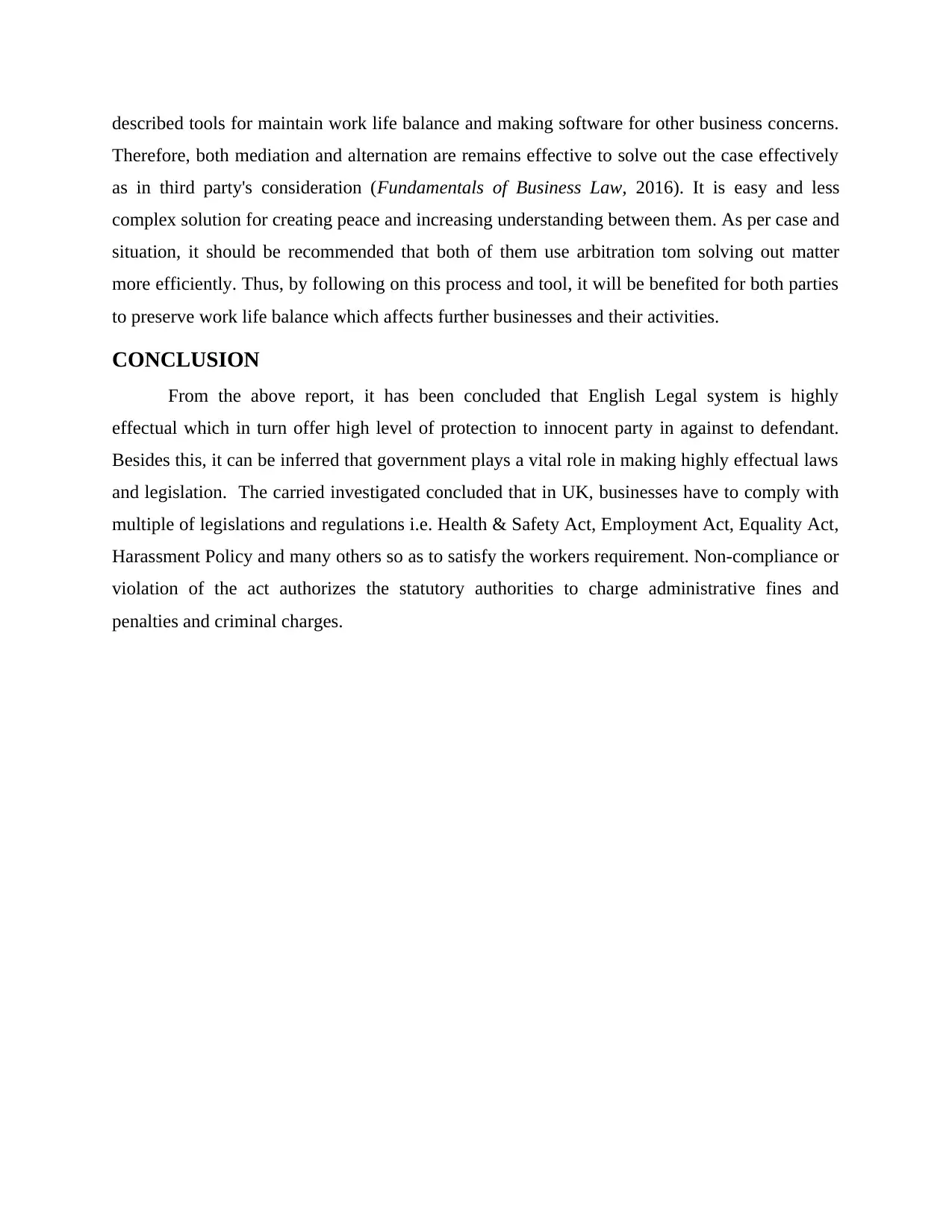
described tools for maintain work life balance and making software for other business concerns.
Therefore, both mediation and alternation are remains effective to solve out the case effectively
as in third party's consideration (Fundamentals of Business Law, 2016). It is easy and less
complex solution for creating peace and increasing understanding between them. As per case and
situation, it should be recommended that both of them use arbitration tom solving out matter
more efficiently. Thus, by following on this process and tool, it will be benefited for both parties
to preserve work life balance which affects further businesses and their activities.
CONCLUSION
From the above report, it has been concluded that English Legal system is highly
effectual which in turn offer high level of protection to innocent party in against to defendant.
Besides this, it can be inferred that government plays a vital role in making highly effectual laws
and legislation. The carried investigated concluded that in UK, businesses have to comply with
multiple of legislations and regulations i.e. Health & Safety Act, Employment Act, Equality Act,
Harassment Policy and many others so as to satisfy the workers requirement. Non-compliance or
violation of the act authorizes the statutory authorities to charge administrative fines and
penalties and criminal charges.
Therefore, both mediation and alternation are remains effective to solve out the case effectively
as in third party's consideration (Fundamentals of Business Law, 2016). It is easy and less
complex solution for creating peace and increasing understanding between them. As per case and
situation, it should be recommended that both of them use arbitration tom solving out matter
more efficiently. Thus, by following on this process and tool, it will be benefited for both parties
to preserve work life balance which affects further businesses and their activities.
CONCLUSION
From the above report, it has been concluded that English Legal system is highly
effectual which in turn offer high level of protection to innocent party in against to defendant.
Besides this, it can be inferred that government plays a vital role in making highly effectual laws
and legislation. The carried investigated concluded that in UK, businesses have to comply with
multiple of legislations and regulations i.e. Health & Safety Act, Employment Act, Equality Act,
Harassment Policy and many others so as to satisfy the workers requirement. Non-compliance or
violation of the act authorizes the statutory authorities to charge administrative fines and
penalties and criminal charges.
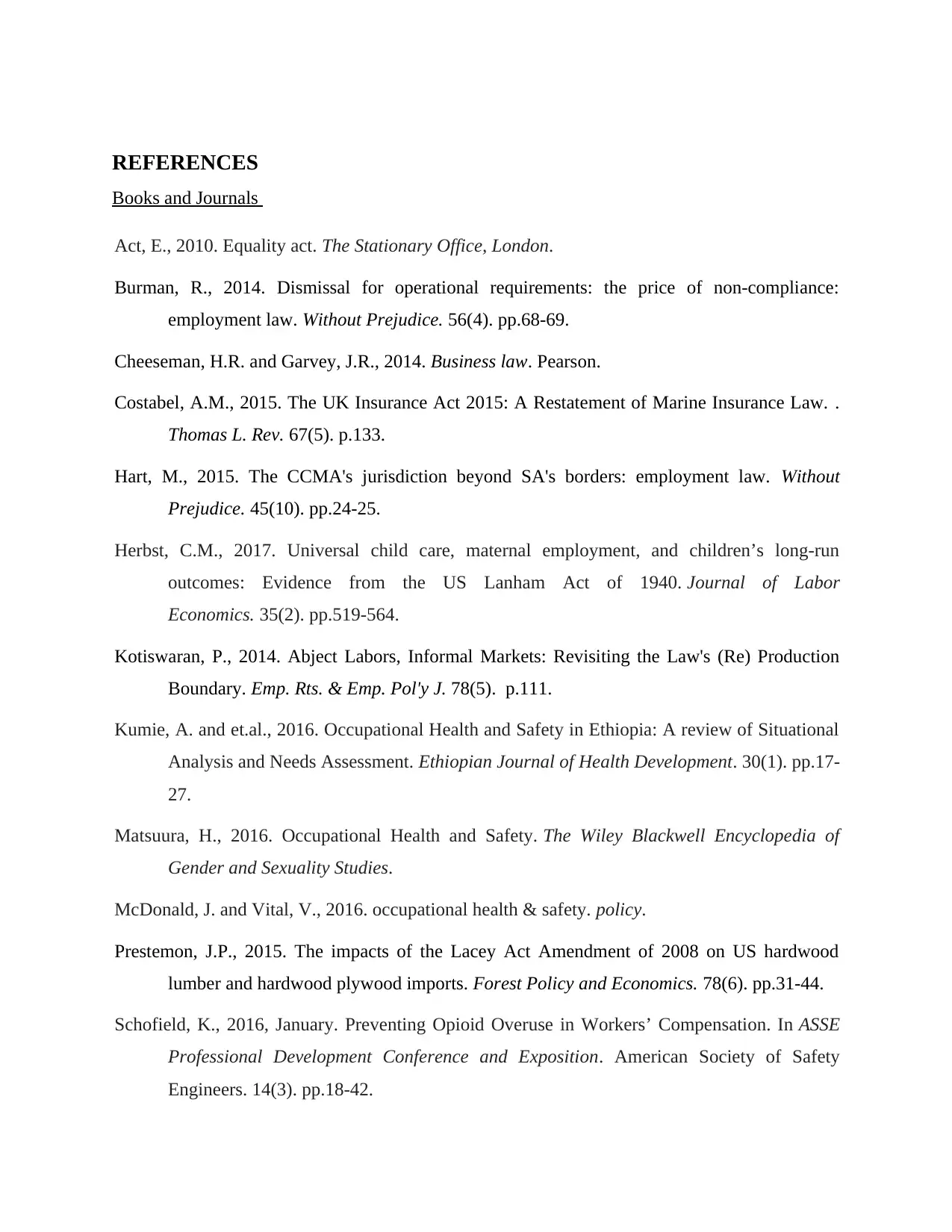
REFERENCES
Books and Journals
Act, E., 2010. Equality act. The Stationary Office, London.
Burman, R., 2014. Dismissal for operational requirements: the price of non-compliance:
employment law. Without Prejudice. 56(4). pp.68-69.
Cheeseman, H.R. and Garvey, J.R., 2014. Business law. Pearson.
Costabel, A.M., 2015. The UK Insurance Act 2015: A Restatement of Marine Insurance Law. .
Thomas L. Rev. 67(5). p.133.
Hart, M., 2015. The CCMA's jurisdiction beyond SA's borders: employment law. Without
Prejudice. 45(10). pp.24-25.
Herbst, C.M., 2017. Universal child care, maternal employment, and children’s long-run
outcomes: Evidence from the US Lanham Act of 1940. Journal of Labor
Economics. 35(2). pp.519-564.
Kotiswaran, P., 2014. Abject Labors, Informal Markets: Revisiting the Law's (Re) Production
Boundary. Emp. Rts. & Emp. Pol'y J. 78(5). p.111.
Kumie, A. and et.al., 2016. Occupational Health and Safety in Ethiopia: A review of Situational
Analysis and Needs Assessment. Ethiopian Journal of Health Development. 30(1). pp.17-
27.
Matsuura, H., 2016. Occupational Health and Safety. The Wiley Blackwell Encyclopedia of
Gender and Sexuality Studies.
McDonald, J. and Vital, V., 2016. occupational health & safety. policy.
Prestemon, J.P., 2015. The impacts of the Lacey Act Amendment of 2008 on US hardwood
lumber and hardwood plywood imports. Forest Policy and Economics. 78(6). pp.31-44.
Schofield, K., 2016, January. Preventing Opioid Overuse in Workers’ Compensation. In ASSE
Professional Development Conference and Exposition. American Society of Safety
Engineers. 14(3). pp.18-42.
Books and Journals
Act, E., 2010. Equality act. The Stationary Office, London.
Burman, R., 2014. Dismissal for operational requirements: the price of non-compliance:
employment law. Without Prejudice. 56(4). pp.68-69.
Cheeseman, H.R. and Garvey, J.R., 2014. Business law. Pearson.
Costabel, A.M., 2015. The UK Insurance Act 2015: A Restatement of Marine Insurance Law. .
Thomas L. Rev. 67(5). p.133.
Hart, M., 2015. The CCMA's jurisdiction beyond SA's borders: employment law. Without
Prejudice. 45(10). pp.24-25.
Herbst, C.M., 2017. Universal child care, maternal employment, and children’s long-run
outcomes: Evidence from the US Lanham Act of 1940. Journal of Labor
Economics. 35(2). pp.519-564.
Kotiswaran, P., 2014. Abject Labors, Informal Markets: Revisiting the Law's (Re) Production
Boundary. Emp. Rts. & Emp. Pol'y J. 78(5). p.111.
Kumie, A. and et.al., 2016. Occupational Health and Safety in Ethiopia: A review of Situational
Analysis and Needs Assessment. Ethiopian Journal of Health Development. 30(1). pp.17-
27.
Matsuura, H., 2016. Occupational Health and Safety. The Wiley Blackwell Encyclopedia of
Gender and Sexuality Studies.
McDonald, J. and Vital, V., 2016. occupational health & safety. policy.
Prestemon, J.P., 2015. The impacts of the Lacey Act Amendment of 2008 on US hardwood
lumber and hardwood plywood imports. Forest Policy and Economics. 78(6). pp.31-44.
Schofield, K., 2016, January. Preventing Opioid Overuse in Workers’ Compensation. In ASSE
Professional Development Conference and Exposition. American Society of Safety
Engineers. 14(3). pp.18-42.
⊘ This is a preview!⊘
Do you want full access?
Subscribe today to unlock all pages.

Trusted by 1+ million students worldwide
1 out of 14
Related Documents
Your All-in-One AI-Powered Toolkit for Academic Success.
+13062052269
info@desklib.com
Available 24*7 on WhatsApp / Email
![[object Object]](/_next/static/media/star-bottom.7253800d.svg)
Unlock your academic potential
Copyright © 2020–2026 A2Z Services. All Rights Reserved. Developed and managed by ZUCOL.





